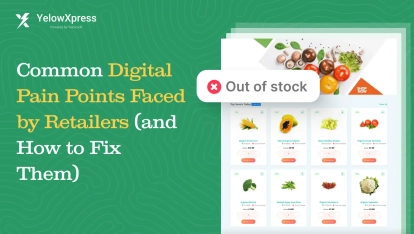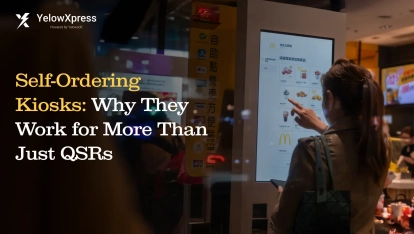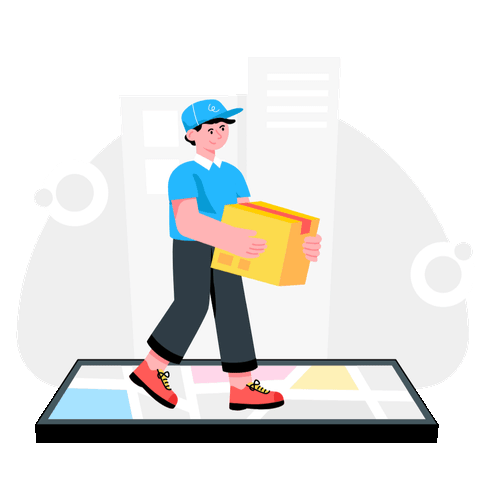If you run a restaurant, a delivery business, a grocery store, or any kind of on-demand operation… your customers want more than just a menu.
They want control. They want speed. And they want an experience that feels smart, seamless, and entirely self-serve.
That’s the new reality.
In fact, a recent study found that 84% of consumers now prefer self-service kiosks over human interaction when ordering food or checking out. It’s not about avoiding people. It’s about efficiency, hygiene, and convenience — and they’re willing to switch brands for it.
This is no passing phase. It’s a full-blown on-demand delivery trend that’s rewriting how businesses operate in 2025.
Whether it's contact-less delivery software powering doorstep orders or a kiosk streamlining in-store checkout, this technology is not optional anymore. It’s expected.
In this blog, we will be going deep into the rise of contactless & self-service tech.
While reading this blog, you’ll learn what sparked this revolution, how self-service tools exploded across industries, and what’s driving this massive shift in customer behavior.
I’ll also break down real numbers and show you what smart businesses are doing right now to stay ahead.
Because if you don’t adopt the trend and the tech today… your competitor will.
How It All Started — The Origin of the Contactless Revolution
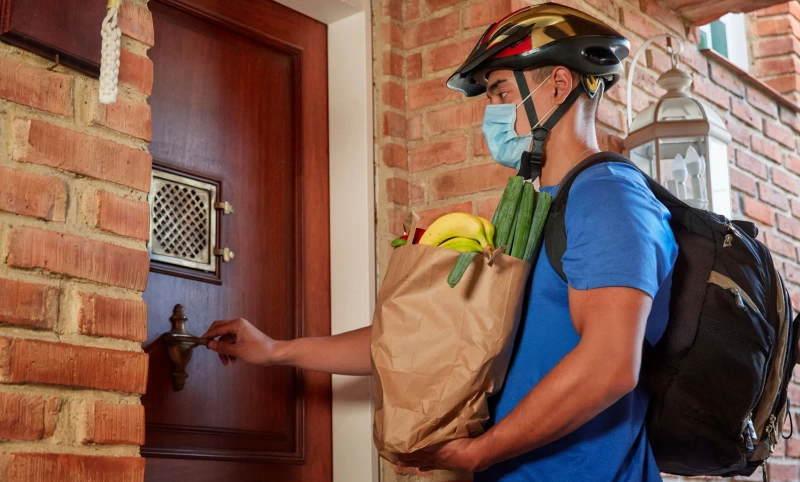
Before QR codes were on every tabletop and kiosks started replacing staff, businesses felt... analogue.
You printed flyers, handed out menus, took calls for delivery, and maybe, just maybe had a card machine that worked on the second swipe.
Back then, contact-less delivery software wasn’t a priority. It wasn’t even on most people’s radar. Why would it be? The systems in place had always “worked.”
But “working” isn’t the same as “winning.”
And when the world flipped in 2020, everyone found out the hard way.
Let’s break it down, starting with what the world looked like right before everything changed.
The Pre-2020 Landscape
Walk into almost any restaurant before 2020, and here’s what you’d see:
- Paper menus
- A long queue at the counter
- A staff member scribbling orders while juggling a phone call
- A payment terminal from 2012
- A tip jar with someone’s dog on it
Charming? Sure.
Efficient? Not really.
The entire ordering process was manual.
Staff took orders. Staff entered them. Staff managed cash, cards, complaints, and confusion.
And for delivery? You were lucky if the driver showed up on time with the right address and the full order.
Self-service kiosk software was still mostly for airports and movie theatres.
Contact-less delivery software was reserved for companies with tech budgets and IT teams.
Everyone else relied on staff, paper, and hope.
That was the norm.
Until suddenly, it wasn’t.
The Catalyst — COVID-19’s Role in Tech Acceleration
When the pandemic hit, it didn’t knock on the door.
It kicked it down and rewrote the rulebook.
Suddenly, touching a menu felt unsafe. Talking to someone across a counter felt risky. Handling change felt... outdated.
The entire world started thinking in terms of distance, hygiene, and minimizing friction.
That’s when on-demand delivery trends exploded.
From fast-food joints to neighborhood grocers, everyone started looking for ways to serve customers without physical contact.
And guess what happened?
The global contactless payment market hit $52 billion in 2024, and it’s projected to grow to $196 billion by 2033.
That’s not a trend. That’s a tidal wave.
QR code menus became standard. Curbside pickup became expected. Branded apps and delivery orchestration platforms became survival tools.
What began as a health measure turned into a new business model — one that prioritized speed, safety, and customer control.
And if you were quick to adapt, you didn’t just stay open — you grew stronger.
Ready to explore modern delivery models that your customers actually want?
Why Customers Now Expect Contactless Experiences?
We just talked about how businesses were forced to evolve. But here’s the twist. While companies were scrambling to survive, customers were quietly upgrading their expectations.
What started as a safety measure became a preference. That preference became a habit. And now? It’s the new default.
Today’s customer walks in expecting that you’ve figured this out. If you have not, then they will happily leave you and find someone who has.
The Standard Has Shifted (And It's Not Going Back)
Let’s say you own a pizza place. A customer walks in, looks around… no self-order kiosk. The staff’s busy. Menus are faded. Ordering feels slow.
Trust me, you have lost that customer without even saying “hi”.
Because this same customer used a restaurant ordering kiosk software last week.
He placed a full order in 40 seconds, split the bill, added extra toppings, and got real-time prep updates. That’s a smooth, touchless, and personalized flow every customer needs in 2025.
And this is the new normal.
Speed, Hygiene, and Zero Confusion Win Every Time
Customers now expect:
- To order fast
- To avoid awkward interaction
- To feel in control
That’s exactly what contact-less delivery software and self-service kiosk solutions offer.
Stat: 65% of U.S. adults used digital wallets in July 2024
Stat: 84% of U.S. consumers prefer kiosks over staffed counters
These aren’t optional upgrades. They’re the bare minimum for today’s customer journey.
The Emotional Trigger
What do customers really want?
It’s not just speed or hygiene.
It’s this:
“I want to order fast, pay instantly, avoid talking to anyone, and not have my food touched by five people.”
It’s the fantasy of a fast, private and frictionless experience. And honestly? Brands that deliver this win.
Here’s the perfect tweet that sums it up:

“i love contactless delivery they just throw the slop at your door and i run out like a little pig.” — @acechhh
Because it’s funny. Because it’s true. And because it shows just how much expectations have shifted, for good.
From Trend to Standard — The Growth of Self-Service Tech
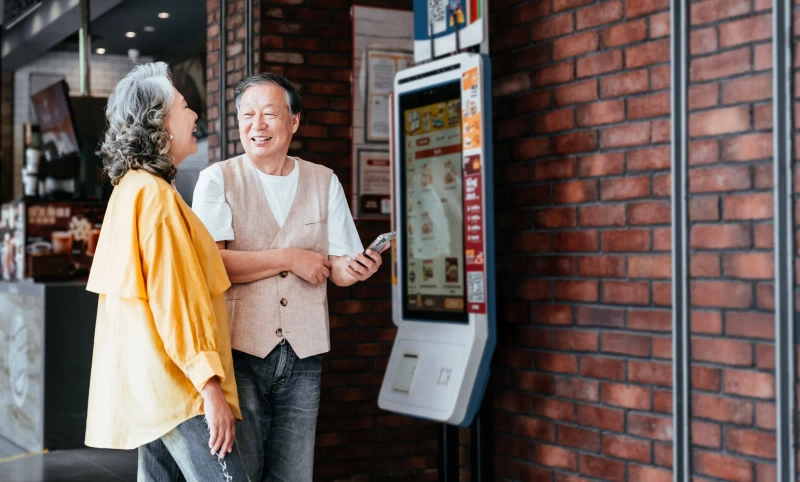
By now, it’s clear that customers expect better.
They want faster ordering, cleaner handoffs, and zero confusion. And when you give it to them, they don’t just appreciate it. They come back.
Now let’s look at how the tech evolved to meet that demand.
Because what started as a trend has quietly become standard operating procedure.
Kiosk Systems Are Everywhere Now
Just a few years ago, spotting a self-ordering kiosk outside of an airport was rare.
But now? They are everywhere.
From local cafés to big-box grocery stores, self-service kiosk software has made its way into almost every industry you can think of.
- You walk into a coffee shop — there's a kiosk.
- You step into a pharmacy — there’s a kiosk.
Even some high-end appliance stores are using them to help customers browse and check out faster.
And this is not just some novelty. It’s a full-blown tech wave.
According to Grand View Research, the self-service kiosk market was valued at $34.36 billion in 2024, and it’s growing at a CAGR of 10.9% through 2030.
Why? Because kiosks don’t just reduce staff workload.
They increase order speed, minimize errors, and improve upsells — all while making customers feel like they’re in control.
That’s what today’s buyer wants: autonomy without complexity.
QSR & Restaurant Adoption
Quick-service restaurants were among the first to jump in — and the results speak for themselves.
Big brands like McDonald’s, Subway, and Shake Shack have been investing heavily in restaurant ordering kiosk software not just to streamline operations, but to increase customer satisfaction and order value.
Think about the last time you walked into a McDonald’s. Did you stand in line… or did you head straight to the glowing screen?
Chances are, you went to the kiosk. Why? Because it was easier. Faster. More predictable.
That’s the power of smart tech — it turns casual customers into loyal ones, and long lines into smooth flows.
Now, even smaller restaurants are adopting the same model.
Because if it works for global brands, it can absolutely work for local ones, especially when platforms like YelowXpress make it affordable.
Real Use Cases Across Industries
The truth is, self-service tech has gone way beyond food.
You’ll find it in:
- Cafés: Let customers grab and go
- Pharmacies: Refill prescriptions or buy essentials without standing in line
- Grocery stores: Self-checkout without cashier delays
- Appliance shops: Browse specs, compare models, and pay — all at a kiosk
No matter the vertical, the goal is the same:
Faster service. Lower costs. Happier customers.
And that’s exactly what self-ordering kiosks deliver without asking you to rebuild your entire business.
If you’re curious how kiosks fit into your operations, check this out:
How Businesses Are Responding (and Winning)?
The businesses that are thriving right now are not just relying on luck. They’re working from a new playbook.
They’ve stopped reacting and started rebuilding operations around automation, self-service, and branded digital ordering.
From streamlining deliveries to launching their own apps to swapping queues for kiosks, they’ve leaned into tech that does more and costs less than you’d expect.
And while others are still figuring things out, these businesses are already converting faster, growing leaner, and winning customers every day.
So, what exactly are they doing differently? Let’s walk through it.
The New Playbook
Let’s start with the shift in strategy.
The best businesses didn’t wait for customers to come back. They gave them a reason to.
They ditched guesswork and built systems designed around what modern customers value most: control, convenience, and confidence.
Here’s what that looks like today:
-
Automated delivery assignments — no more juggling spreadsheets or WhatsApp orders
-
Branded digital ordering systems — apps and websites that customers recognize instantly
-
Self-checkouts and kiosks — turning queues into smooth, hands-free workflows
-
Live status updates — so no one’s left wondering when their order will arrive
This isn’t theory — it’s happening right now.
Whether it’s a single-location burger joint or a 50-outlet grocery chain, the playbook is the same:
Cut the manual work. Create digital flow. Make it easy to come back.
The Technology Stack That Powers It
So, what’s powering this shift?
It’s not complex. It’s just smart.
The most agile businesses today are running on integrated, flexible, plug-and-play tools that work together without breaking the bank.
Here’s what that stack typically includes:
-
A contact-less delivery software engine that assigns, routes, and tracks deliveries in real time
-
A digital ordering system that works across web and mobile — and carries your brand, not someone else’s
-
A restaurant kiosk software module that turns a simple screen into a revenue-generating, queue-busting assistant
-
A smart admin panel that lets you see everything — orders, drivers, payments, analytics — in one dashboard
-
A vendor app that syncs orders to kitchens or store staff instantly
-
And of course, the customer app — clean, intuitive, and built for repeat orders
Together, these tools reduce operational stress, increase speed, and improve accuracy.
No more disconnected systems. No more missed orders. Just one seamless backend powering a better customer experience.
How YelowXpress Fits In?
This is where it gets exciting.
At YelowXpress, we’ve built a platform that gives you everything we just mentioned — but designed it for real-world teams who don’t have time (or budget) to figure out ten tools and a custom dev team.
Here’s how we help you launch smarter:
-
White-label, branded solutions — your logo, your colors, your control
-
Modular product suite — use what you need: kiosks, POS, dispatch, or the whole stack
-
Fast to market — most businesses go live in under 14 days
-
Scalable architecture — grow from one outlet to 100 without rebuilding the system
-
Affordable SaaS model — predictable pricing that grows with you, not against you
From contact-less delivery management to self-ordering kiosks, from admin dashboards to customer apps — it’s all built to fit your business like a glove.
So whether you're a small QSR, a multi-store grocery brand, or a startup building the next big on-demand service…
YelowXpress gives you the tools to compete like the giants.
Adapting Without Breaking the Bank
Not every business has the luxury of big tech budgets or in-house development teams.
And guess what? You don’t need them.
Because adapting to today’s contactless, on-demand world isn’t about going all-in on a custom solution you’ll spend six months building and six figures maintaining.
It’s about making smart, modular moves — using ready-to-launch tools that give you the same advantages as the big players, without the overhead.
And that’s exactly what businesses are doing right now to stay lean, move fast, and still deliver an experience that feels top-tier.
Let’s break down how they’re doing it.
Affordable Entry Points
If you’re just getting started or want to test the waters without blowing the budget, there’s a fast-track.
Many businesses are launching with ready-made Zomato or UberEats clone apps — white-label platforms that give them branded apps, real-time delivery tracking, and a backend built for scale… all without building from scratch.
It’s not about copying. It’s about using proven flows and interfaces that your customers already trust — just with your brand in the spotlight.
Want to see how that looks in action?
Use What You Need (Scalable Modules)
Not every business needs the full stack on day one.
That’s the beauty of modular SaaS — start with what matters most, then expand as you grow.
Need just a kiosk? Done.
Want to integrate POS with delivery? Easy.
Looking to manage multi-vendor orders across cities? Covered.
Here’s what businesses are using, piece by piece:
- POS & KDS: Sync orders to the kitchen in real time
- Customer & Driver Apps: Real-time tracking, easy UX
- Self-ordering Kiosks: Reduce queues, increase AOV
- Admin Panel: Track, manage, and automate operations
- Vendor Panel: Let partners fulfill orders without manual input
You’re never locked in. You scale on your terms.
Examples of What a 14-Day Rollout Can Look Like
Here’s the wild part — most of our clients go live in under two weeks.
A 14-day rollout isn’t hype. It’s possible because the tech is ready, proven, and built for fast onboarding.
- Day 1: Choose your modules
- Day 3: Branding & configurations
- Day 7: App build + admin training
- Day 14: Live ordering, delivery, and kiosk flows in production
No chaos. No delays.
Just a smooth, done-for-you launch that puts your brand online — fast.
Want To Go Digital ASAP?
The Future — What’s Next for On-Demand Delivery Tech?
We’ve seen where we were. We’ve broken down where we are.
Now let’s talk about where things are going.
Because the businesses are adapting today?
They’re not just thinking about customer experience in 2024.
They’re building for what’s coming next — AI-driven logistics, voice-powered ordering, facial recognition, and automation that runs itself while you sleep.
Sounds futuristic?
Not really. Most of it is already in play.
Let’s look at what’s around the corner — and how you can stay ready.
AI in Dispatching and Operations
Imagine a system that doesn’t just assign deliveries…
But learns from traffic, weather, and driver habits to route smarter every time.
That’s not a prototype — that’s AI-powered dispatch, and it’s already being used to reduce delivery times, cut fuel costs, and boost customer satisfaction.
Smart automation isn’t just replacing manual labor.
It’s making your delivery orchestration system think like your best ops manager — but faster, and always on.
Voice & Facial Recognition for Ordering
We’re getting closer to a world where the phrase “Would you like the usual?” isn’t coming from a person — it’s coming from your ordering screen.
Voice ordering is gaining traction in both in-store and mobile environments, letting users place entire orders hands-free.
And with facial recognition, loyalty programs and personalization can happen automatically — offering faster checkouts, saved preferences, and frictionless reordering.
It’s not about gimmicks.
It’s about reducing steps and increasing conversion with zero input effort.
Autonomous Vehicles & Smart Delivery Hubs
They’re not mainstream yet, but they’re not sci-fi either.
From drone deliveries to sidewalk bots, autonomous logistics is gaining traction — especially in last-mile scenarios where speed and cost-efficiency matter most.
Combine that with smart lockers, pickup stations, and dark kitchens, and you’ve got a hyper-efficient model for delivering more with fewer moving parts.
The bottom line?
Tech is moving fast — and your delivery management software needs to be ready to integrate, scale, and evolve without friction.
Final Thoughts — The Tech Isn’t Optional Anymore
Let’s not sugarcoat it.
In 2025, the tech you use is the experience you deliver.
If you're still relying on manual order taking, handwritten dockets, or phone-based dispatch — you're not just behind on tools. You're behind on what your customers now expect.
Because here's the truth: On-demand delivery trends are no longer being led by startups or tech giants.
They’re being shaped by everyday businesses who made the smart move early.
Businesses like yours.
Whether it's a restaurant ordering kiosk software setup that eliminates wait times, or a contact-less delivery software platform that automates everything from dispatch to doorstep — the shift is here. It’s working. And it’s accelerating.
And those who embrace it will not just survive but will thrive and scale.
So here’s the question:
Are you going to wait and watch… or move and lead?
Don't get left behind in the delivery tech race.
FAQs
Contactless delivery software is a digital tool that allows businesses to manage online orders and deliveries without any physical interaction between the customer and delivery staff.
Self-service kiosk systems are becoming so popular in restaurants because customers love speed and control. A self-service kiosk software lets them order at their own pace, skip queues, and get exactly what they want without needing to repeat anything at the counter.
Small businesses can afford contactless delivery tech by choosing a ready-to-use white label contactless delivery software provider like Yelowxpress.
Opting for Yelowxpress does not require a small business owner to have a huge budget. Yelowxpress offers an affordable Saas-based contactless delivery system that is ready to launch and scale as your business grows.
The key features of a restaurant ordering kiosk software includes menu browsing, upselling prompts, customizations, multi-language support, and direct POS integration — all designed for a better customer experience.
The key difference between contactless delivery and traditional delivery is no physical handoff. With contact-less delivery, the driver drops the order outside, notifies the customer digitally, and completes the delivery through the app. This makes it safer, faster, and fully touch-free.
Yes! Using a white-label delivery app or a Zomato clone lets you launch a branded platform with delivery tracking, restaurant/vendor panels, and customer apps without building it from scratch.
With tools like YelowXpress, most businesses can launch a branded contactless ordering system complete with web, app, and kiosk in under 14 days.
Not at all. Many small restaurants, cafes, and even grocery stores are using self-ordering kiosk systems to reduce costs and serve customers faster. Moreover, it’s more affordable than most think.
Digital ordering systems streamline the process, reduce order errors, speed up service, and increase upsell opportunities — all while giving customers more control.
Yes, modern contactless delivery platforms like YelowXpress support full integration with POS, KDS, kiosks, and more, so everything runs smoothly behind the scenes.


